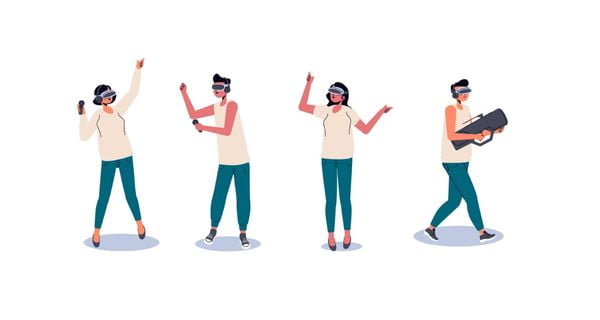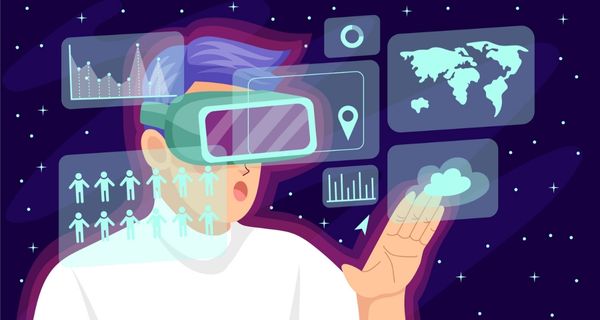Extended Reality (XR) is a revolutionary technology changing how we interact with digital content and the world around us. XR encompasses a variety of immersive technologies – Virtual Reality (VR), Augmented Reality (AR), and Mixed Reality (MR), to create a seamless blend of digital and physical content. XR technology provides users with an engaging and immersive experience that feels real and immediate, allowing them to explore, experiment, and interact with digital content in new and innovative ways. Whether gaming, education, healthcare, or entertainment, XR technology is poised to revolutionize our lives, work, and play. So, prepare to step into the future and discover what XR technology has in store for you!
Before diving into exploring the fascinating developments and applications of XR technology, let us first define extended reality.
So, What is Extended Reality Technology?
There are three technological segments under the primary branch of Extended Reality XR technologies, each with unique features and applications. And the extended reality is a blend of these technologies.
Virtual Reality (VR):
It is cutting-edge technology that provides users with a fully immersive experience in a computer-generated environment. With VR, users wear a headset that covers their eyes and ears, providing a 360-degree view of the virtual world and realistic audio effects. This allows users to feel as though they are physically present in the virtual world and interact with the environment in real time. With its ability to create realistic and engaging experiences, VR transforms how people interact with digital content and the world around them. Whether exploring a new environment, playing a game, or attending a virtual event, VR paves the way for a new era of digital experiences.
Augmented Reality (AR):
It is a technology that fills the real world-world environment with digital content, enhancing it with information and visual elements. AR is typically achieved through a smartphone or tablet camera, which allows users to view the real world with digital content added. This creates a unique experience where digital content is seamlessly integrated into the real world in a meaningful way. AR has a wide range of applications, from retail and advertising to tourism and education. With its ability to provide real-time information about the physical world, AR can revolutionize how people interact with information and the world around them. Whether learning about a new product, exploring a new city, or engaging with a new form of advertising, AR is changing how we experience the world.
Mixed Reality (MR):
It is a technology that combines VR and AR to create a hybrid experience where digital content is seamlessly integrated into the real world. Mixed Reality (MR) technology is a blend of Virtual Reality (VR) and Augmented Reality (AR) that creates a steady integration of digital content into the real world. MR allows users to interact with virtual objects and environments naturally and intuitively. Unlike VR, which creates a fully immersive experience, or AR, which enhances the real world with digital content, MR combines the best of both worlds to create an immersive and interactive hybrid experience. MR technology revolutionizes the way people interact with digital content and the physical world, creating new opportunities for gaming, entertainment, education, and beyond.
Exploring the power of Cloud-Extended Reality
Cloud Extended Reality (XR) refers to the use of cloud computing to power XR experiences, including Virtual Reality (VR), Augmented Reality (AR), and Mixed Reality (MR). By leveraging the power and resources of the cloud, Cloud XR can provide users with more immersive and interactive XR experiences while also reducing the cost and complexity of creating and deploying XR applications.
Cloud XR allows users to access XR content and experiences from remote servers rather than relying on local devices’ processing power and storage capacity. This allows for more sophisticated XR experiences, as the cloud can provide users access to powerful hardware and software resources that would otherwise be unavailable on local devices. For example, Cloud XR can create high-quality graphics and animations and support real-time interactions and multiplayer experiences.
One of the key benefits of Cloud XR is the ability to offload processing and storage requirements from local devices, freeing up resources for other tasks. This can result in a better user experience, as the demands of XR content and experiences do not slow down local devices. Additionally, because Cloud XR experiences are hosted in the cloud, they can be accessed from any device with an internet connection, making them more accessible and convenient.
Another benefit of Cloud XR is the ability to scale XR experiences to meet the needs of many users, as cloud computing resources can be allocated as needed to ensure that XR experiences remain fast and responsive. This is particularly important for multiplayer XR experiences, where many users can simultaneously access the same experience.
Utilization of Extended Reality Headsets

Extended Reality headsets are an essential component of the XR ecosystem, providing users with a means of accessing and interacting with XR content and experiences. XR headsets come in various forms, including VR, AR, and MR headsets, each with unique features and capabilities.
VR headsets are designed to fully immerse users in a virtual world, providing them with a 360-degree view of the virtual environment and allowing them to interact with digital content in real time. AR and MR headsets, on the other hand, blend digital content with the physical world, providing users with a more integrated and natural experience.
One critical factor that separates XR headsets from traditional displays is their ability to track the movements of the user’s head and body, allowing for a more natural and immersive experience. In addition, XR headsets may include features such as hand-based controllers, haptic feedback, and audio input/output, further enhancing the immersive experience.
In conclusion, Cloud XR and XR headsets are two essential components of the XR ecosystem, working together to provide users with more immersive and interactive XR experiences. By leveraging the power and resources of the cloud and providing users with a means of accessing XR content, Cloud XR and XR headsets are helping to shape the future of XR technology and paving the way for new and innovative XR experiences.
Industry Use-Case of Extended Reality (XR):

One of the most significant extended reality examples can be seen in the gaming industry. VR gaming has been growing in popularity in recent years with the release of standalone VR devices and VR games. The immersive experience offered by VR has been a huge selling point for gamers, who can now enter virtual worlds and interact with digital objects as if they were real. The gaming industry has already shown how XR can be used to provide a highly engaging and immersive experience, and this concept is being extended to other industries as well.
Another industry that has been quick to embrace XR technology is the retail sector. Retail companies are using AR to provide customers with a more interactive shopping experience. For example, a customer can use their smartphone to point at a piece of furniture in a store, and an AR overlay will show them how the furniture and the interiors would look in their home. This allows customers to visualize how a product looks in their home to make a confident buying decision, thus, reducing the likelihood of returns.
XR is also being exercised in the construction and architecture industries to create virtual prototypes and walk-throughs of buildings. This allows architects and engineers to visualize their designs and make changes before the building is constructed, reducing the likelihood of mistakes and increasing efficiency.
Characteristics of XR
To summarize again, Extended Reality (XR) is a term used to encompass the various forms of immersive and interactive technologies. Some of the key characteristics of XR technology include the following:
1. Immersive experience:
XR provides a fully immersive experience that allows users to interact with digital content intrinsically and intuitively. Whether exploring a virtual world or enhancing the physical world with digital content, XR technology creates an experience that feels real and immediate.
2. Interactivity:
XR provides users with a high level of interactivity, allowing them to manipulate digital content in real time. This creates an engaging and dynamic experience that encourages exploration and experimentation.
3. Multisensory experience:
XR provides a multisensory experience that engages users on multiple levels. This includes visual, auditory, and even tactile sensations, making the experience more immersive and realistic.
4. Personalized experience:
XR technology can be customized to create a customized experience for each user, considering their preferences, interests, and needs. This allows for a highly individualized experience tailored to each person’s unique needs and goals.
5. Accessibility:
XR technology is designed to be accessible to everyone, regardless of physical abilities or technological knowledge. This includes features such as voice and gesture controls, making it easier for everyone to participate and enjoy the experience.
6. Innovation:
XR is an evolving field constantly pushing the boundaries of what is possible in terms of immersive and interactive experiences. With new developments in hardware and software, XR has the potential to continue to change the way we interact with digital content and the world around us.
In summary, XR technology offers a new way to interact with digital content and the world around us, creating experiences that are immersive, interactive, and engaging.
Key Takeaways
The Extended Reality industry is rapidly evolving with remarkable growth in today’s era and ongoing technological advancements. With its ability to create immersive and interactive experiences, XR has the potential to revolutionize a wide range of industries, including gaming, education, healthcare, and entertainment.
So, if you are looking to integrate XR into your workflow, no-code platforms like PlugXR can give you the competitive edge. As XR technology continues to develop and mature, so do the features of cutting-edge platforms. You will be able to create viral-worthy content, likely to be an increasingly important part of our daily lives, changing how we learn, work, and play. With its cross-platform compatibility, accessibility, and innovative nature, XR is an exciting and rapidly growing field that is well worth keeping an eye on. Whether you’re a tech enthusiast, gamer, student, or professional, XR technology will indeed have something for everyone, so explore what it offers!

